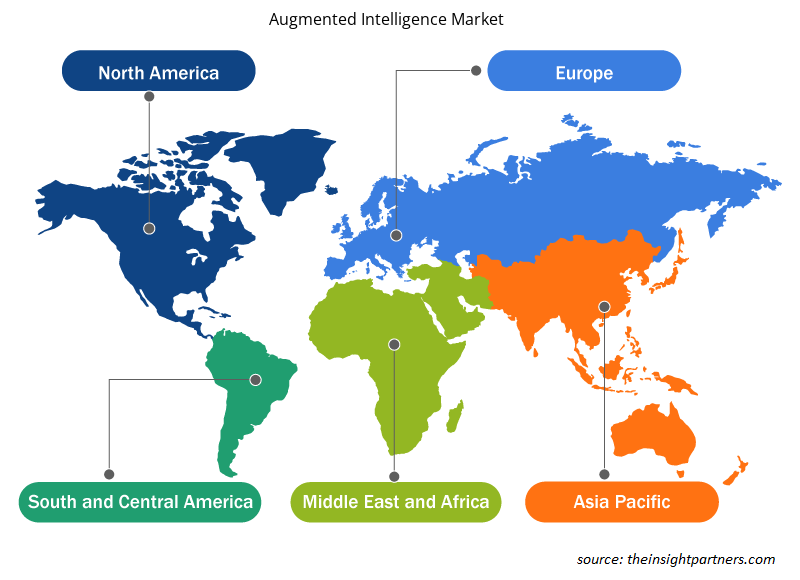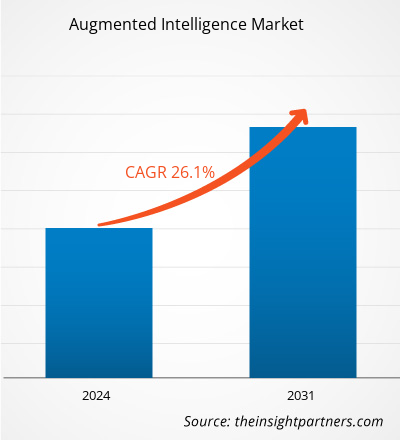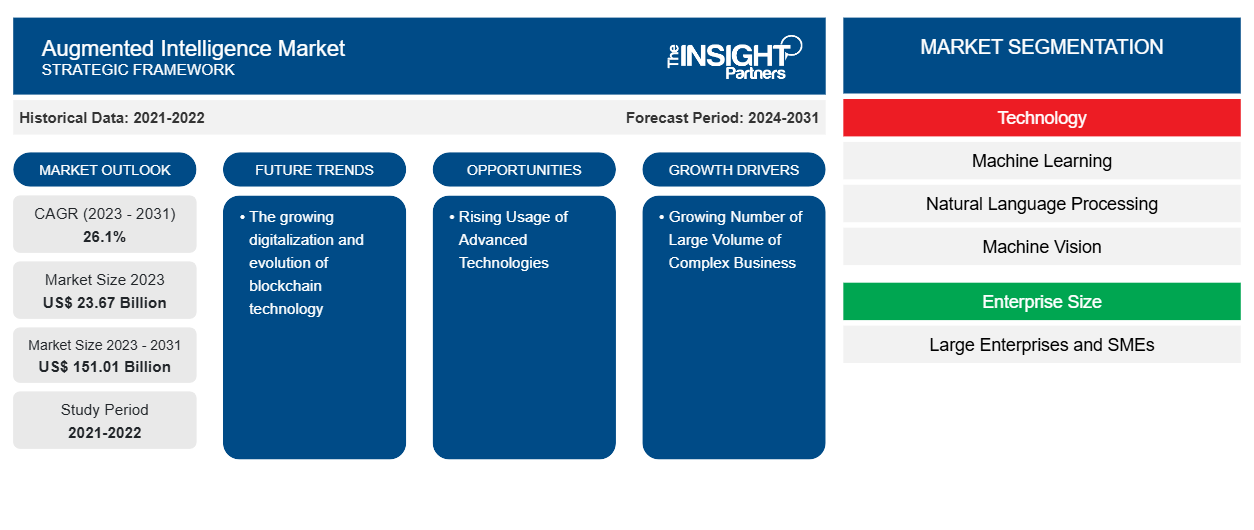من المتوقع أن يصل حجم سوق الذكاء المعزز إلى 151.01 مليار دولار أمريكي بحلول عام 2031 من 23.67 مليار دولار أمريكي في عام 2023. ومن المتوقع أن يسجل السوق معدل نمو سنوي مركب بنسبة 26.1٪ في الفترة 2023-2031. ومن المرجح أن يظل التحول الرقمي المتزايد وتطور تقنية blockchain اتجاهًا رئيسيًا في سوق الذكاء المعزز.
تحليل سوق الذكاء المعزز
يشهد سوق الذكاء المعزز نموًا سريعًا بسبب العدد المتزايد من الكميات الكبيرة من بيانات الأعمال المعقدة وتوسع قطاعات الخدمات المصرفية والمالية والتأمين وتكنولوجيا المعلومات والاتصالات والتجزئة والتجارة الإلكترونية. ويتوسع السوق بشكل مطرد، مدفوعًا بالتبني المتزايد للذكاء المعزز بين الشركات الصغيرة والمتوسطة الحجم. وعلاوة على ذلك، فإن الاستخدام المتزايد للتكنولوجيات المتقدمة والتبني المتزايد للحلول المستندة إلى السحابة بين الشركات يوفر فرصًا مربحة لنمو السوق.
نظرة عامة على سوق الذكاء المعزز
الذكاء المعزز هو نوع من الذكاء الاصطناعي يركز على القدرات المساعدة للذكاء الاصطناعي. بالإضافة إلى ذلك، يتم إنشاء الذكاء المعزز لدعم المؤسسات في اتخاذ قرارات أكثر دقة تعتمد على البيانات في الأعمال والحياة اليومية. علاوة على ذلك، تستخدم الشركات الذكاء المعزز لتحسين أداء موظفيها ومساعدة المؤسسة في فهم مجالات التحسين لدى الموظفين مما يحرك السوق. بالإضافة إلى ذلك، يعد الذكاء المعزز التقنية الأكثر فعالية لاستخدام مجموعة كبيرة من بيانات الأمان وإعطائها الأولوية من خلال تقديم تحليلات تنبؤية للمؤسسات.
قم بتخصيص هذا التقرير ليناسب متطلباتك
ستحصل على تخصيص لأي تقرير - مجانًا - بما في ذلك أجزاء من هذا التقرير، أو تحليل على مستوى الدولة، وحزمة بيانات Excel، بالإضافة إلى الاستفادة من العروض والخصومات الرائعة للشركات الناشئة والجامعات
-
احصل على أهم اتجاهات السوق الرئيسية لهذا التقرير.ستتضمن هذه العينة المجانية تحليلاً للبيانات، بدءًا من اتجاهات السوق وحتى التقديرات والتوقعات.
محركات وفرص سوق الذكاء المعزز
العدد المتزايد من البيانات التجارية المعقدة ذات الحجم الكبير هو المحرك للسوق
أصبحت تقنيات الذكاء المعزز، مثل التعلم الآلي ومعالجة اللغة الطبيعية، ذات أهمية متزايدة لتحليل البيانات. يتيح الذكاء المعزز تحليل مصادر البيانات المنظمة وشبه المنظمة وغير المنظمة المخزنة داخل الشركات. ومن المتوقع أن يرتفع تنوع وحجم البيانات التي يتم إنشاؤها بشكل كبير في السنوات القادمة المرتبطة بالصناعات المتوسعة وتطور التقنيات الرقمية عبر عمليات الشركة. وهذا يزيد من الطلب على حلول الذكاء المعزز بين الشركات لإدارة حجمها الكبير من البيانات بشكل فعال وكفء. ومع ذلك، من المتوقع أن يؤدي الحجم المتزايد من البيانات المعقدة إلى تغذية سوق الذكاء المعزز خلال الفترة الزمنية المتوقعة.
الاستخدام المتزايد للتقنيات المتقدمة – فرصة في سوق الذكاء المعزز
إن الاستخدام المتزايد للتقنيات المتقدمة مثل الذكاء الاصطناعي والتعلم الآلي وتقنيات معالجة اللغة الطبيعية يخلق فرصًا لنمو السوق خلال فترة التنبؤ. تولد العديد من الصناعات، مثل تكنولوجيا المعلومات والاتصالات وتجارة التجزئة والتجارة الإلكترونية والخدمات المصرفية والمالية والتأمين والرعاية الصحية وغيرها، كميات هائلة من البيانات وتتطلب تقنيات متقدمة لتحليل هذه البيانات في الوقت الفعلي، مما يزيد من الطلب على حلول الذكاء المعزز. تتبنى الصناعات تقنيات جديدة مثل الذكاء الاصطناعي والتعلم الآلي ومعالجة اللغة الطبيعية لتحليل البيانات الضخمة من خلال اتخاذ قرارات فعالة في الوقت الفعلي. لقد عملت هذه الأدوات على تبسيط عملية استخراج الأفكار من البيانات، مما يزيد من اعتمادها ويخلق فرصًا في السوق.
تقرير تحليل تجزئة سوق الذكاء المعزز
القطاعات الرئيسية التي ساهمت في استخلاص تحليل سوق الذكاء المعزز هي التكنولوجيا وحجم المؤسسة والمستخدم النهائي
- استنادًا إلى التكنولوجيا، ينقسم سوق الذكاء المعزز إلى التعلم الآلي، ومعالجة اللغة الطبيعية، والرؤية الآلية، والحوسبة الواعية بالسياق، وغيرها. احتل قطاع التعلم الآلي حصة سوقية أكبر في عام 2023.
- من حيث حجم المؤسسة، تم تقسيم السوق إلى شركات كبيرة وشركات صغيرة ومتوسطة الحجم. وقد استحوذت شريحة الشركات الصغيرة والمتوسطة الحجم على حصة سوقية أكبر في عام 2023.
- من حيث المستخدم النهائي، يتم تصنيف السوق على أنها تكنولوجيا المعلومات والاتصالات، وتجارة التجزئة والتجارة الإلكترونية، والخدمات المصرفية والمالية والتأمين، والرعاية الصحية، وغيرها. احتل قطاع الخدمات المصرفية والمالية والتأمين حصة سوقية أكبر في عام 2023.
تحليل حصة سوق الذكاء المعزز حسب المنطقة الجغرافية
ينقسم النطاق الجغرافي لتقرير سوق الذكاء المعزز بشكل أساسي إلى خمس مناطق: أمريكا الشمالية، ومنطقة آسيا والمحيط الهادئ، وأوروبا، والشرق الأوسط وأفريقيا، وأمريكا الجنوبية/أمريكا الجنوبية والوسطى.
من حيث الإيرادات، استحوذت أمريكا الشمالية على أكبر حصة في سوق الذكاء المعزز، وذلك بسبب التقدم التكنولوجي ووجود لاعبين رئيسيين، بما في ذلك IBM Corporation وMicrosoft Corporation وTIBCO Software Inc. وSalesforce.com، Inc. وMicroStrategy Incorporated. يستثمر هؤلاء اللاعبون بشكل كبير في تبني التقنيات المتقدمة مثل الذكاء الاصطناعي والتعلم الآلي ومعالجة اللغة الطبيعية ويشاركون باستمرار في تطوير هذه التقنيات من خلال إضافة ميزات إضافية. من المتوقع أن يؤدي الطلب المتزايد على الذكاء المعزز المستند إلى السحابة بين الصناعات بما في ذلك تكنولوجيا المعلومات والاتصالات والخدمات المصرفية والمالية والتجزئة والتجارة الإلكترونية والرعاية الصحية وغيرها إلى تعزيز السوق في أمريكا الشمالية.
رؤى إقليمية حول سوق الذكاء المعزز
لقد قام المحللون في Insight Partners بشرح الاتجاهات والعوامل الإقليمية المؤثرة على سوق الاستخبارات المعززة طوال فترة التنبؤ بشكل شامل. يناقش هذا القسم أيضًا قطاعات سوق الاستخبارات المعززة والجغرافيا في جميع أنحاء أمريكا الشمالية وأوروبا ومنطقة آسيا والمحيط الهادئ والشرق الأوسط وأفريقيا وأمريكا الجنوبية والوسطى.

- احصل على البيانات الإقليمية المحددة لسوق الذكاء المعزز
نطاق تقرير سوق الذكاء المعزز
| سمة التقرير | تفاصيل |
|---|---|
| حجم السوق في عام 2023 | 23.67 مليار دولار أمريكي |
| حجم السوق بحلول عام 2031 | 151.01 مليار دولار أمريكي |
| معدل النمو السنوي المركب العالمي (2023 - 2031) | 26.1% |
| البيانات التاريخية | 2021-2022 |
| فترة التنبؤ | 2024-2031 |
| القطاعات المغطاة |
حسب التكنولوجيا
|
| المناطق والدول المغطاة |
أمريكا الشمالية
|
| قادة السوق وملفات تعريف الشركات الرئيسية |
|
كثافة اللاعبين في سوق الذكاء المعزز: فهم تأثيرها على ديناميكيات الأعمال
يشهد سوق الذكاء المعزز نموًا سريعًا، مدفوعًا بالطلب المتزايد من المستخدم النهائي بسبب عوامل مثل تفضيلات المستهلكين المتطورة والتقدم التكنولوجي والوعي المتزايد بفوائد المنتج. ومع ارتفاع الطلب، تعمل الشركات على توسيع عروضها والابتكار لتلبية احتياجات المستهلكين والاستفادة من الاتجاهات الناشئة، مما يؤدي إلى زيادة نمو السوق.
تشير كثافة اللاعبين في السوق إلى توزيع الشركات أو المؤسسات العاملة في سوق أو صناعة معينة. وهي تشير إلى عدد المنافسين (اللاعبين في السوق) الموجودين في مساحة سوق معينة نسبة إلى حجمها أو قيمتها السوقية الإجمالية.
الشركات الرئيسية العاملة في سوق الذكاء المعزز هي:
- شركة آي بي إم
- شركة مايكروسوفت
- ساب اس اي
- شركة تيبكو للبرمجيات
- شركة سيسنس
- شركة Salesforce.com
إخلاء المسؤولية : الشركات المذكورة أعلاه ليست مرتبة بأي ترتيب معين.

- احصل على نظرة عامة على أهم اللاعبين الرئيسيين في سوق الذكاء المعزز
أخبار سوق الذكاء المعزز والتطورات الأخيرة
يتم تقييم سوق الذكاء المعزز من خلال جمع البيانات النوعية والكمية بعد البحث الأولي والثانوي، والتي تتضمن منشورات الشركات المهمة وبيانات الجمعيات وقواعد البيانات. فيما يلي قائمة بالتطورات في سوق الذكاء المعزز والاستراتيجيات:
- في سبتمبر 2023، عرضت شركة Oracle Corp اليوم قدرات جديدة مدعومة بالذكاء الاصطناعي ضمن Oracle Analytics Cloud. تساعد قدرات الذكاء الاصطناعي الجديدة ذاتية الخدمة، بما في ذلك مساعدي الذكاء الاصطناعي التوليديين والتحليلات المعززة، المؤسسات على تحسين كيفية تأثير البيانات على عملية اتخاذ القرار. (المصدر: Oracle Corp، بيان صحفي، 2023)
تغطية تقرير سوق الذكاء المعزز والمنتجات النهائية
يوفر تقرير "حجم سوق الذكاء المعزز والتوقعات (2021-2031)" تحليلاً مفصلاً للسوق يغطي المجالات التالية:
- حجم السوق والتوقعات على المستويات العالمية والإقليمية والوطنية لجميع قطاعات السوق الرئيسية التي يغطيها النطاق
- ديناميكيات السوق مثل المحركات والقيود والفرص الرئيسية
- الاتجاهات المستقبلية الرئيسية
- تحليل مفصل لقوى PEST/Porter الخمس وSWOT
- تحليل السوق العالمي والإقليمي الذي يغطي اتجاهات السوق الرئيسية واللاعبين الرئيسيين واللوائح والتطورات الأخيرة في السوق
- تحليل المشهد الصناعي والمنافسة الذي يغطي تركيز السوق، وتحليل خريطة الحرارة، واللاعبين البارزين، والتطورات الأخيرة
- ملفات تعريف الشركة التفصيلية
- التحليل التاريخي (سنتان)، سنة الأساس، التوقعات (7 سنوات) مع معدل النمو السنوي المركب
- تحليل PEST و SWOT
- حجم السوق والقيمة / الحجم - عالمي، إقليمي، بلد
- الصناعة والمنافسة
- مجموعة بيانات إكسل
التقارير الحديثة
شهادات العملاء
سبب الشراء
- اتخاذ قرارات مدروسة
- فهم ديناميكيات السوق
- تحليل المنافسة
- رؤى العملاء
- توقعات السوق
- تخفيف المخاطر
- التخطيط الاستراتيجي
- مبررات الاستثمار
- تحديد الأسواق الناشئة
- تحسين استراتيجيات التسويق
- تعزيز الكفاءة التشغيلية
- مواكبة التوجهات التنظيمية























 احصل على عينة مجانية ل - سوق الذكاء المعزز
احصل على عينة مجانية ل - سوق الذكاء المعزز